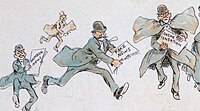
Photo from wikipedia
ABSTRACT This article aims to provide a resource for journalism researchers looking to use a qualitative approach to study news use. It seeks to go beyond justifying qualitative methods vis-à-vis… Click to show full abstract
ABSTRACT This article aims to provide a resource for journalism researchers looking to use a qualitative approach to study news use. It seeks to go beyond justifying qualitative methods vis-à-vis quantitative methods and to be more reflective and critical regarding the limitations and possibilities of the qualitative interview. Making the case for taking experience as point of departure for studying news use, the article explicates this notion by drawing from different theoretical conceptions of experience. Based on three recent user studies, the article critically reflects upon three interview-based methods that center around users’ experience of news use—the think-aloud protocol, watching and discussing news, and the two-sided video-ethnography—and discusses their theoretical, methodological and epistemological implications. A common thread emerging from the different user studies is that people require support to be able to access and communicate their experiences of news use. The methods discussed proved successful at doing so, respectively by having informants comment on what they saw right in front of them (see), by giving them the tools and the vocabulary to reflect on a prior experience (think), and by bringing them in touch with their sensations of using news (feel).
Journal Title: Journalism Studies
Year Published: 2020
Link to full text (if available)
Share on Social Media: Sign Up to like & get
recommendations!